NumPy空数组:高效创建和操作未初始化数组的完整指南
NumPy是Python中用于科学计算的核心库,它提供了强大的多维数组对象和丰富的数学函数。在NumPy中,空数组是一种特殊类型的数组,它在创建时不会初始化元素值。本文将深入探讨NumPy空数组的概念、创建方法、应用场景以及相关操作,帮助您更好地理解和使用这一重要功能。
1. 什么是NumPy空数组?
NumPy空数组是指在创建时不会为数组元素分配具体值的数组。这些数组在内存中分配了空间,但其中的值是未定义的。空数组通常用于提高性能,特别是在需要预分配大量内存但不需要立即初始化值的情况下。
以下是创建NumPy空数组的基本示例:
import numpy as np
# 创建一个形状为(3, 4)的空数组
empty_array = np.empty((3, 4))
print("Empty array from numpyarray.com:")
print(empty_array)
Output:

在这个例子中,我们使用np.empty()函数创建了一个3行4列的空数组。需要注意的是,虽然我们称之为”空”数组,但实际上它包含了随机的、未初始化的值。
2. 为什么使用NumPy空数组?
使用NumPy空数组有几个主要优势:
- 性能优化:创建空数组比创建预填充值的数组更快,因为它不需要初始化元素。
- 内存效率:当您知道稍后会覆盖所有值时,使用空数组可以避免不必要的内存操作。
- 灵活性:空数组允许您根据特定需求逐个设置元素值。
3. 创建NumPy空数组的方法
3.1 使用np.empty()
np.empty()是创建空数组最直接的方法。它接受一个表示数组形状的元组作为参数。
import numpy as np
# 创建一维空数组
empty_1d = np.empty(5)
print("1D empty array from numpyarray.com:")
print(empty_1d)
# 创建二维空数组
empty_2d = np.empty((2, 3))
print("2D empty array from numpyarray.com:")
print(empty_2d)
# 创建三维空数组
empty_3d = np.empty((2, 3, 4))
print("3D empty array from numpyarray.com:")
print(empty_3d)
Output:
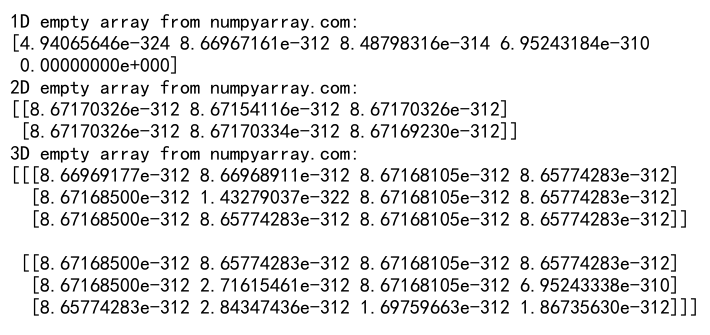
这些例子展示了如何创建不同维度的空数组。注意,打印出的值是未初始化的,可能会显示随机数据。
3.2 使用np.empty_like()
np.empty_like()函数创建一个与给定数组具有相同形状和数据类型的新空数组。
import numpy as np
# 创建一个示例数组
original_array = np.array([[1, 2, 3], [4, 5, 6]])
# 创建一个与original_array形状相同的空数组
empty_like_array = np.empty_like(original_array)
print("Original array from numpyarray.com:")
print(original_array)
print("Empty array with same shape from numpyarray.com:")
print(empty_like_array)
Output:
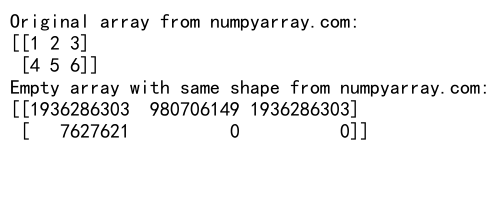
这个方法特别有用,当您需要创建一个与现有数组具有相同结构但不需要复制其值的新数组时。
3.3 指定数据类型
创建空数组时,您可以指定所需的数据类型:
import numpy as np
# 创建float32类型的空数组
empty_float32 = np.empty((2, 2), dtype=np.float32)
print("Float32 empty array from numpyarray.com:")
print(empty_float32)
# 创建int64类型的空数组
empty_int64 = np.empty((2, 2), dtype=np.int64)
print("Int64 empty array from numpyarray.com:")
print(empty_int64)
Output:
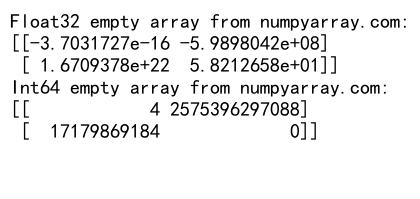
指定数据类型可以确保数组元素具有所需的精度和内存使用特性。
4. 操作NumPy空数组
创建空数组后,您通常需要对其进行操作以填充有意义的数据。以下是一些常见操作:
4.1 填充空数组
您可以使用索引或切片来填充空数组:
import numpy as np
# 创建一个3x3的空数组
empty_array = np.empty((3, 3))
# 使用循环填充数组
for i in range(3):
for j in range(3):
empty_array[i, j] = i * 3 + j
print("Filled array from numpyarray.com:")
print(empty_array)
Output:
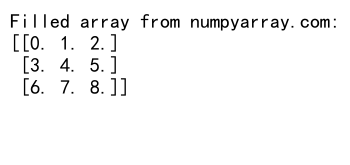
这个例子展示了如何使用嵌套循环来填充空数组。
4.2 使用广播填充空数组
NumPy的广播功能允许您高效地填充空数组:
import numpy as np
# 创建一个4x4的空数组
empty_array = np.empty((4, 4))
# 使用广播填充数组
empty_array[:] = np.arange(16).reshape(4, 4)
print("Array filled using broadcasting from numpyarray.com:")
print(empty_array)
Output:
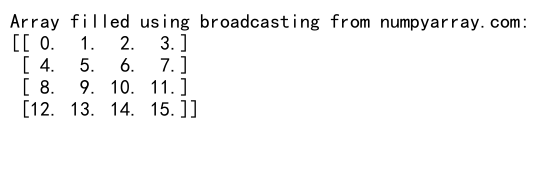
这个例子使用np.arange()创建一个序列,然后通过广播将其填充到空数组中。
4.3 使用数学运算
您可以对空数组执行数学运算来填充它:
import numpy as np
# 创建一个5x5的空数组
empty_array = np.empty((5, 5))
# 使用数学运算填充数组
x = np.arange(5)
y = np.arange(5)[:, np.newaxis]
empty_array[:] = x + y
print("Array filled using mathematical operations from numpyarray.com:")
print(empty_array)
Output:

这个例子展示了如何使用NumPy的数学运算和广播来填充空数组。
5. 空数组的应用场景
空数组在多种情况下都非常有用,以下是一些常见的应用场景:
5.1 性能优化
当您需要创建一个大数组并稍后填充它时,使用空数组可以提高性能:
import numpy as np
import time
# 使用zeros创建大数组
start_time = time.time()
zeros_array = np.zeros((10000, 10000))
zeros_time = time.time() - start_time
# 使用empty创建大数组
start_time = time.time()
empty_array = np.empty((10000, 10000))
empty_time = time.time() - start_time
print(f"Time to create zeros array: {zeros_time:.6f} seconds")
print(f"Time to create empty array: {empty_time:.6f} seconds")
print("Performance comparison from numpyarray.com")
Output:

这个例子比较了使用np.zeros()和np.empty()创建大数组的时间差异。通常,np.empty()会更快,因为它不需要初始化元素。
5.2 预分配内存
在进行复杂计算时,预分配内存可以提高效率:
import numpy as np
def compute_squares(n):
# 预分配结果数组
result = np.empty(n)
for i in range(n):
result[i] = i ** 2
return result
squares = compute_squares(10)
print("Computed squares using pre-allocated array from numpyarray.com:")
print(squares)
Output:

在这个例子中,我们预分配了一个空数组来存储计算结果,这比动态增长列表更高效。
5.3 图像处理
在图像处理中,空数组常用于创建输出图像:
import numpy as np
def apply_threshold(image, threshold):
# 创建与输入图像相同形状的空数组
result = np.empty_like(image)
# 应用阈值
result[:] = np.where(image > threshold, 255, 0)
return result
# 模拟一个简单的灰度图像
image = np.random.randint(0, 256, (100, 100))
# 应用阈值
thresholded_image = apply_threshold(image, 128)
print("Image thresholding example from numpyarray.com")
print(f"Original image shape: {image.shape}")
print(f"Thresholded image shape: {thresholded_image.shape}")
Output:

这个例子展示了如何使用空数组在图像处理中创建输出图像。
6. 空数组的注意事项
虽然空数组非常有用,但使用时需要注意以下几点:
6.1 未初始化的值
空数组包含未初始化的值,这可能导致不可预测的行为:
import numpy as np
# 创建一个空数组
empty_array = np.empty((3, 3))
print("Uninitialized values in empty array from numpyarray.com:")
print(empty_array)
# 尝试使用未初始化的值
result = np.sum(empty_array)
print(f"Sum of uninitialized values: {result}")
Output:

这个例子展示了空数组中未初始化值的潜在问题。在使用空数组之前,确保所有元素都已正确初始化是很重要的。
6.2 内存管理
创建大型空数组时要小心,因为它们会立即分配内存:
import numpy as np
# 创建一个非常大的空数组
try:
huge_array = np.empty((1000000, 1000000))
print("Successfully created a huge array from numpyarray.com")
except MemoryError:
print("Memory error occurred when creating huge array from numpyarray.com")
Output:

这个例子尝试创建一个非常大的空数组,可能会导致内存错误。在处理大型数据集时,要注意内存限制。
6.3 数据类型一致性
确保在填充空数组时保持数据类型一致性:
import numpy as np
# 创建一个float类型的空数组
empty_float = np.empty((3, 3), dtype=float)
# 尝试用整数填充
empty_float[:] = [[1, 2, 3], [4, 5, 6], [7, 8, 9]]
print("Float array filled with integers from numpyarray.com:")
print(empty_float)
Output:

这个例子展示了如何用整数填充浮点型空数组。注意NumPy会自动将整数转换为浮点数。
7. 空数组与其他数组创建方法的比较
了解空数组与其他数组创建方法的区别很重要:
7.1 np.empty() vs np.zeros()
import numpy as np
# 创建空数组
empty_array = np.empty((3, 3))
# 创建零数组
zeros_array = np.zeros((3, 3))
print("Empty array from numpyarray.com:")
print(empty_array)
print("\nZeros array from numpyarray.com:")
print(zeros_array)
Output:
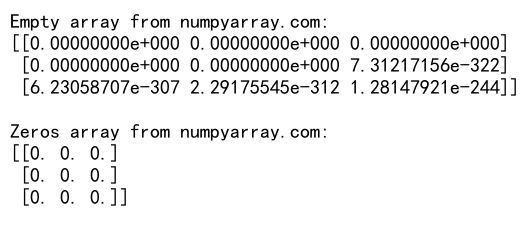
np.empty()创建未初始化的数组,而np.zeros()创建所有元素都为0的数组。
7.2 np.empty() vs np.ones()
import numpy as np
# 创建空数组
empty_array = np.empty((3, 3))
# 创建全1数组
ones_array = np.ones((3, 3))
print("Empty array from numpyarray.com:")
print(empty_array)
print("\nOnes array from numpyarray.com:")
print(ones_array)
Output:
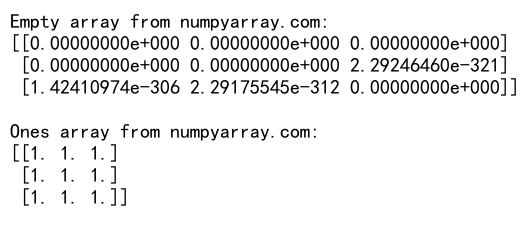
np.empty()创建未初始化的数组,而np.ones()创建所有元素都为1的数组。
7.3 np.empty() vs np.full()
import numpy as np
# 创建空数组
empty_array = np.empty((3, 3))
# 创建填充特定值的数组
full_array = np.full((3, 3), 5)
print("Empty array from numpyarray.com:")
print(empty_array)
print("\nFull array from numpyarray.com:")
print(full_array)
Output:

np.empty()创建未初始化的数组,而np.full()创建所有元素都为指定值的数组。
8. 高级应用:结合空数组与其他NumPy功能
空数组可以与其他NumPy功能结合使用,以实现更复杂的操作:
8.1 使用空数组进行矩阵运算
import numpy as np
# 创建两个2x2的空矩阵
matrix1 = np.empty((2, 2))
matrix2 = np.empty((2, 2))
# 填充矩阵
matrix1[:] = [[1, 2], [3, 4]]
matrix2[:] = [[5, 6], [7, 8]]
# 矩阵乘法
result = np.dot(matrix1, matrix2)
print("Matrix multiplication result from numpyarray.com:")
print(result)
Output:

这个例子展示了如何使用空数组创建矩阵并进行矩阵乘法。
8.2 使用空数组进行数值积分
import numpy as np
def integrate_function(func, a, b, n):
# 创建空数组来存储x值和y值
x = np.empty(n)
y = np.empty(n)
# 计算步长
dx = (b - a) / (n - 1)
#填充x和y数组
for i in range(n):
x[i] = a + i * dx
y[i] = func(x[i])
# 使用梯形法则进行积分
integral = np.trapz(y, x)
return integral
# 定义要积分的函数
def f(x):
return x**2
# 计算积分
result = integrate_function(f, 0, 1, 1000)
print(f"Integral of x^2 from 0 to 1 using empty arrays from numpyarray.com: {result}")
Output:

这个例子展示了如何使用空数组来实现数值积分。我们创建了两个空数组来存储x和y值,然后使用梯形法则计算积分。
8.3 使用空数组进行图像滤波
import numpy as np
def apply_filter(image, kernel):
# 获取图像和卷积核的尺寸
i_height, i_width = image.shape
k_height, k_width = kernel.shape
# 计算输出图像的尺寸
o_height = i_height - k_height + 1
o_width = i_width - k_width + 1
# 创建输出图像的空数组
output = np.empty((o_height, o_width))
# 应用卷积
for i in range(o_height):
for j in range(o_width):
output[i, j] = np.sum(image[i:i+k_height, j:j+k_width] * kernel)
return output
# 创建一个示例图像
image = np.random.rand(10, 10)
# 创建一个简单的模糊卷积核
kernel = np.ones((3, 3)) / 9
# 应用滤波
filtered_image = apply_filter(image, kernel)
print("Original image from numpyarray.com:")
print(image)
print("\nFiltered image from numpyarray.com:")
print(filtered_image)
Output:
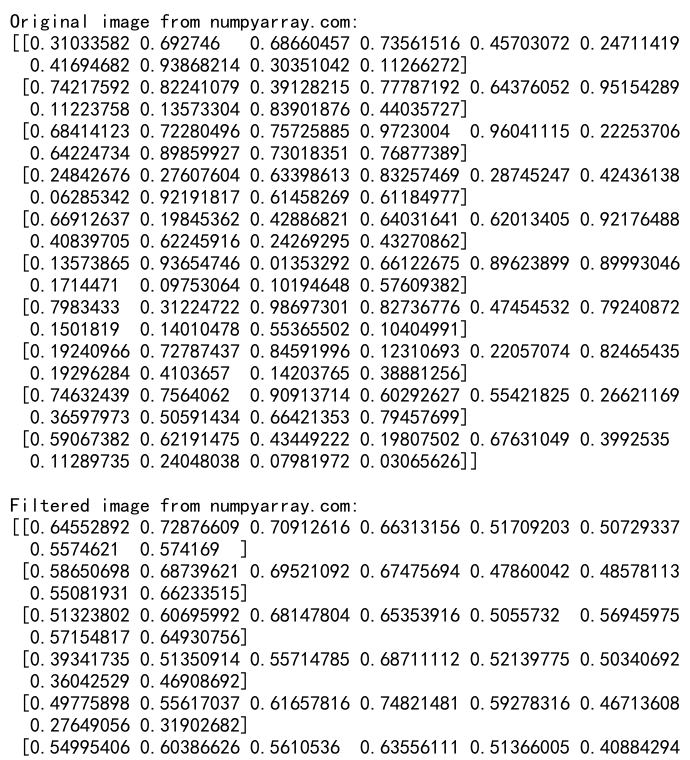
这个例子展示了如何使用空数组来实现简单的图像滤波操作。我们创建了一个空数组来存储滤波后的图像,然后通过卷积操作填充这个数组。
9. 空数组的内存管理和优化
理解空数组的内存管理对于优化NumPy程序非常重要:
9.1 内存视图和共享内存
import numpy as np
# 创建一个大的空数组
big_array = np.empty((1000, 1000))
# 创建一个视图
view = big_array[:500, :500]
# 修改视图
view.fill(1)
print("Memory view example from numpyarray.com:")
print(f"Big array shape: {big_array.shape}")
print(f"View shape: {view.shape}")
print(f"Sum of big array: {np.sum(big_array)}")
Output:
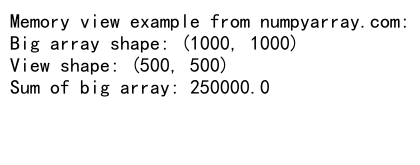
这个例子展示了如何创建大型空数组的视图。修改视图会影响原始数组,因为它们共享相同的内存。
9.2 使用np.frombuffer()创建空数组
import numpy as np
# 创建一个字节缓冲区
buffer = bytearray(1000)
# 从缓冲区创建NumPy数组
array_from_buffer = np.frombuffer(buffer, dtype=np.float64)
print("Array from buffer example from numpyarray.com:")
print(f"Array shape: {array_from_buffer.shape}")
print(f"Array dtype: {array_from_buffer.dtype}")
Output:

这个例子展示了如何从预先分配的内存缓冲区创建NumPy数组。这种方法可以在某些情况下提供更好的内存控制。
9.3 使用np.memmap()处理大型数据集
import numpy as np
import os
# 创建一个内存映射文件
filename = 'numpyarray_com_memmap.dat'
fp = np.memmap(filename, dtype='float32', mode='w+', shape=(1000, 1000))
# 填充一些数据
fp[:] = np.random.random((1000, 1000))
# 刷新到磁盘
fp.flush()
# 删除内存映射
del fp
# 重新打开内存映射文件
fp = np.memmap(filename, dtype='float32', mode='r', shape=(1000, 1000))
print("Memory-mapped file example from numpyarray.com:")
print(f"Array shape: {fp.shape}")
print(f"Array mean: {np.mean(fp)}")
# 清理
del fp
os.remove(filename)
Output:

这个例子展示了如何使用np.memmap()创建内存映射文件。这对于处理大型数据集特别有用,因为它允许您处理比可用RAM更大的数据。
10. 空数组在科学计算中的应用
空数组在各种科学计算任务中都有广泛的应用:
10.1 蒙特卡洛模拟
import numpy as np
def monte_carlo_pi(n):
# 创建空数组来存储随机点
points = np.empty((n, 2))
# 生成随机点
points[:] = np.random.random((n, 2))
# 计算落在单位圆内的点数
inside_circle = np.sum(np.sum(points**2, axis=1) <= 1)
# 估算π
pi_estimate = 4 * inside_circle / n
return pi_estimate
# 运行蒙特卡洛模拟
pi_approx = monte_carlo_pi(1000000)
print(f"Estimated value of pi from numpyarray.com: {pi_approx}")
Output:

这个例子使用空数组来存储随机生成的点,用于蒙特卡洛方法估算π的值。
10.2 数值微分
import numpy as np
def numerical_derivative(func, x, h=1e-5):
# 创建用于计算导数的空数组
df = np.empty_like(x)
# 计算数值导数
df[:] = (func(x + h) - func(x - h)) / (2 * h)
return df
# 定义一个函数
def f(x):
return x**2
# 创建x值数组
x = np.linspace(-5, 5, 100)
# 计算导数
dfdx = numerical_derivative(f, x)
print("Numerical derivative example from numpyarray.com:")
print(f"x values: {x[:5]}...")
print(f"df/dx values: {dfdx[:5]}...")
Output:

这个例子展示了如何使用空数组来计算函数的数值导数。
10.3 信号处理
import numpy as np
def apply_fft(signal):
# 创建空数组来存储FFT结果
fft_result = np.empty(len(signal), dtype=complex)
# 计算FFT
fft_result[:] = np.fft.fft(signal)
return fft_result
# 创建一个简单的信号
t = np.linspace(0, 1, 1000)
signal = np.sin(2 * np.pi * 10 * t) + 0.5 * np.sin(2 * np.pi * 20 * t)
# 应用FFT
fft_result = apply_fft(signal)
print("FFT example from numpyarray.com:")
print(f"Signal shape: {signal.shape}")
print(f"FFT result shape: {fft_result.shape}")
print(f"First 5 FFT values: {fft_result[:5]}")
Output:

这个例子展示了如何使用空数组来存储快速傅里叶变换(FFT)的结果,这在信号处理中非常常见。
结论
NumPy的空数组是一个强大而灵活的工具,在科学计算、数据分析和性能优化中有广泛的应用。通过本文的详细介绍和丰富的示例,我们深入探讨了空数组的创建方法、操作技巧、应用场景以及注意事项。从基本概念到高级应用,我们涵盖了空数组在各种情况下的使用方法,包括性能优化、内存管理、数值计算和科学模拟等。
理解和掌握空数组的使用可以帮助您更有效地处理大型数据集,优化计算性能,并在各种科学计算任务中灵活应用。然而,使用空数组时也需要注意未初始化值和内存管理等潜在问题。通过合理使用空数组,结合NumPy的其他功能,您可以开发出更高效、更强大的数据处理和科学计算程序。
无论您是数据科学家、研究人员还是软件开发者,掌握NumPy空数组的使用技巧都将为您的工作带来显著的效率提升和新的可能性。希望本文能够帮助您更好地理解和应用NumPy空数组,为您的数据分析和科学计算工作提供有力支持。
 极客笔记
极客笔记